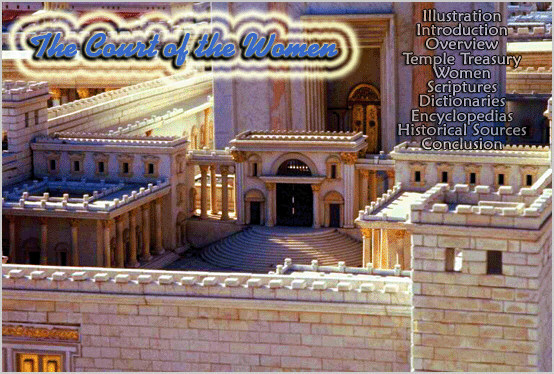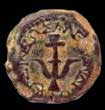The Court of the Women in the Temple
The Colonnades

The Beautiful Columns of the Temple

Entering
the Temple area it
would be easy to notice its double colonnades. Passing
through the Susan
Gate you would come to a large court called "the Court of the Women" not because
there were only women there but because women could not go beyond it. There were
smaller courts with columns in the four corners of the court. According to the
Mishnah (Middoth 2,5) the Women's Court was was just over 200 feet square
between bounding lines. Each court on the outside was 60 feet square. A large
colonnade ran around the court, and within it, against the wall, the thirteen
chests, or 'trumpets,' for charitable contributions were placed.

The Colonnades of
the Temple. The historian Josephus describes the Second Temple colonnades:
"All the cloisters were double, and the pillars to them belonging were
twenty-five cubits in height, and supported -the cloisters. These pillars were
of one entire stone each of them, and that stone was white marble; and the roofs
were adorned with cedar, curiously graven. The natural magnificence, and
excellent polish, and the harmony of the joints in these cloisters, afforded a
prospect that was very remarkable; nor was it on the outside adorned with any
work of the painter or engraver. The cloisters -(of the outmost court) were in
breadth thirty cubits, while the entire compass of it was by measure six
furlongs, including the tower of Antonia; those entire courts that were exposed
to the air were laid with stones of all sorts" (Jewish War 5. 5. 2).
The Royal Portico.
The eastern portico was named after King Solomon and the part to the south,
which overlooked the Valley of Kidron, was called "Royal." On the east side the
high corner was possibly the pinnacle of the temple, mentioned in the story of
the temptation of Jesus (Matthew 4:5). When Jesus came to Jerusalem, the Temple
had just been marvelously rebuilt by Herod the Great. The Temple area had been
enlarged to a size of about thirty-five acres. Around the Temple area were
double colonnades. Read
More about The Jerusalem Temple.
--------------------------
Some
Commentary Notes:
Jewish Encyclopedia. The Cloisters.
Around the entire interior of this wall were ranged porticoes or cloisters. The
finest were those on the south. They consisted of four rows of Corinthian
columns of white marble; and there were 162 columns in all. The ceilings were of
carved wood ("Ant." xv. 11, � 5; "B. J." v. 5, � 2). The eastern cloister was
known as "Solomon's Porch" (John x. 23; Acts iii. 11, v. 12); it must
accordingly have been believed that there were here Solomonic substructures.
Edersheim - The
musical instruments used by the Levites were deposited in two rooms under the
Court of the Israelites, to which the access was from the Court of the Women. Of
course the western colonnade of this court was open. Thence fifteen easy steps
led through the so-called Gate of Nicanor into the Court of Israel. On these
steps the Levites were wont on the Feast of Tabernacles to sing the fifteen
'Psalms of Degrees,' or ascent (Psalms 120 to 134), whence some have derived
their name. Here, or, rather, in the Gate of Nicanor, all that was ordered to be
done 'before the Lord' took place. There the cleansed leper and the women coming
for purification presented themselves to the priests, and there also the 'water
of jealousy' was given to the suspected wife.
Read More
Edersheim - Court of the Women. The Court of the Women obtained its
name, not from its appropriation to the exclusive use of women, but because they
were not allowed to proceed farther, except for sacrificial purposes. Indeed,
this was probably the common place for worship, the females occupying, according
to Jewish tradition, only a raised gallery along three sides of the court. This
court covered a space upwards of 200 feet square. All around ran a simple
colonnade, and within it, against the wall, the thirteen chests, or 'trumpets,'
for charitable contributions were placed.

The Women's Court in the
Temple in Jerusalem

Mark 12:41-44 "Now Jesus sat opposite the treasury and saw how the people
put money into the treasury. And many who were rich put in much. Then one
poor widow came and threw in two mites, which make a quadrans. So He called
His disciples to Himself and said to them, "Assuredly, I say to you that
this poor widow has put in more than all those who have given to the
treasury; for they all put in out of their abundance, but she out of her
poverty put in all that she had, her whole livelihood."
The
Jerusalem Temple
 If you were to approach the Temple in
Jerusalem in the first century A.D. you would pass through the eastern gate
where Jesus made His triumphal entry. Then you would come to the Court of
the Gentiles which was a large court paved with stones of various colors. It
was open to all comers including the cattle-dealers and the money-changers
who desecrated the Temple. This court was also called the Outer Court, the
Lower Court, and the rabbi�s usually called it "the Mountain of the Lord�s
House." All around the Temple proper was a 9 foot high terrace with stairs
which was higher than the Court of the Gentiles. It was surrounded by a 5
foot high wall which was designed to keep out the gentiles. There was also
pillars in the wall at various distances (the Soreg) with inscriptions in
Latin, Greek, and Hebrew, warning all gentiles to come no further under
penalty of death.
If you were to approach the Temple in
Jerusalem in the first century A.D. you would pass through the eastern gate
where Jesus made His triumphal entry. Then you would come to the Court of
the Gentiles which was a large court paved with stones of various colors. It
was open to all comers including the cattle-dealers and the money-changers
who desecrated the Temple. This court was also called the Outer Court, the
Lower Court, and the rabbi�s usually called it "the Mountain of the Lord�s
House." All around the Temple proper was a 9 foot high terrace with stairs
which was higher than the Court of the Gentiles. It was surrounded by a 5
foot high wall which was designed to keep out the gentiles. There was also
pillars in the wall at various distances (the Soreg) with inscriptions in
Latin, Greek, and Hebrew, warning all gentiles to come no further under
penalty of death.
Going beyond the Court of the Gentiles and at the top of the terrace there
was a platform for about 15 feet and then there was another wall. On the
east side stood the magnificent 60 foot wide "Gate Beautiful" mentioned in
Acts 3:2,10. It was also referred to as the "Gate Susan" because it
contained a beautifully sculptured relief of the city of Susa. During the
time of the morning and evening sacrifices this great entrance was the place
of public worship.
Entering through the Susan Gate you would come to a large court called "the
Court of the Women" not because there were only women there but because
women could not go beyond it. There were smaller courts with columns in the
four corners of the court.
According to the Mishnah (Middoth 2,5) the Women's Court was was just over
200 feet square between bounding lines. Each court on the outside was 60
feet square.
In front of these columns were the eleven treasure chests of the Temple for
the voluntary offerings of money, and there were also two at the Gate of
Susan, for the half-shekel tax. Jesus was sitting �opposite the treasury'
when he saw the widow put into one of the containers the two copper coins
which were all that she had (Mark 12:41-44; Lk 21:1-2).
It was near these treasure chests that the man healed of his blindness came
up to Jesus in John 8:20 and worshipped Him.
Continuing eastward there was a magnificent circular staircase and the
Nicanor Gate. Entering through the gate there was a narrow hall filled with
beautiful cloistered columns called "Court of the Israelites" and it was
also through a wall and up a flight of stairs. The Court of the Israelites
surrounded the "Court of the Priests" which was where the altar of sacrifice
was. The women could only glance over a balcony from the Court of the Women
to see the ceremonies inside the Inner Court (According to Middoth).
Illustration
Introduction
Overview
Chel
Beautiful Gate
Nicanor Gate
Circular Steps
Levite Choirs
Oil of Yah Court
Nazarite Court
Leper's Chamber Court
Woodshed Court
Colonnades
Balconies
The Temple Treasury
Women
Scriptures
Dictionaries
Encyclopedias
Historical Sources
Heart Message
An Old
Woman - A Heart Message

Related Content